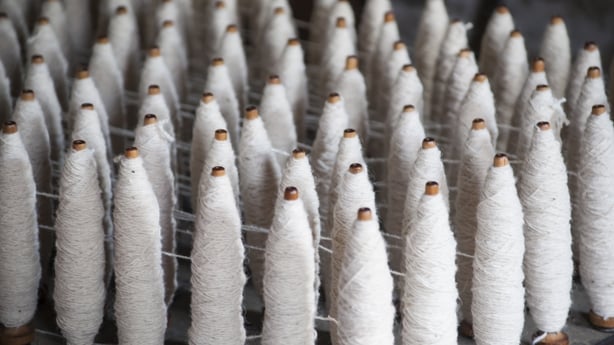Would you wear a Kombucha leather jacket? Crystals made from sweat? Or a silk dress made from orange peels?
These are just some of the organic materials that could usher in a new era in sustainable fashion, as more creators and shoppers ditch fossil fuel-based materials in favour of biodegradable fabrics.
Raw material extraction and processing makes up a huge portion of a brand's carbon footprint, so it is little wonder that as shoppers become more conscious about sustainability, the fashion industry turns their eye to alternative materials.
Biomaterials have been around since people started wearing clothing, but it has developed far beyond using leaves as loincloths. The term refers to materials that come from a natural source, with some link to biological matter and as such, can biodegrade. Classic materials like wool and untreated linen are examples.

As time progressed and what we wanted from our clothing changed, so did the materials our clothes are made from, leaning more on chemically composed textiles as we pushed for clothing to be cheaper and created faster to keep up with rapidly wavering trends.
When it comes to fashion, the most common raw materials that make up our clothing are cotton and polyester. While they are common, they’re very different.
Fossil fuel based fibres like polyester make up more than 62% of textile materials, according to stats from Common Objective, and are used across the board, from haute houses to the hyper-fastest of fashion brands. However, they are mostly associated with cheaper clothing. As they are made from plastics and petroleum, they cannot degrade in the environment.

Meanwhile, cotton comes from the plant of the same name and makes up 26% of materials. While it is degradable, it must be grown, harvested, processed, and spun into a yarn that is ready to be woven or knitted into a fabric, before being transformed into a finished product. This uses huge amounts of resources like water, land and chemicals for processing and farming.
With the push back against polyester in full swing, improving fabrics palatability to Mother Nature is a key driver in exploring new biomaterials. These materials give shoppers alternative options that often use up what we would traditionally deem as waste, and consume less resources like water, chemicals and energy to make.

It also helps change the fast-fashion mindset, as biodegradable clothing allows us to be part of the complete circle of a garment's life if we choose to keep it for decades - we can actually outlive the clothing instead of the other way around.
Among the biomaterials making waves are Kombucha leather - a flexible leather alternative made from the symbiotic culture of bacteria and yeast that creates kombucha - nettle enforced fibres, mycelium leather made from mushroom filaments and algae-based yarn.
It’s even possible to make silks from orange peels, and crystals to embellish clothing from sweat, a creative feat undertaken by London’s Royal College of Art graduate Alice Potts in a collection entitled PERSPIRE.
We need your consent to load this Instagram contentWe use Instagram to manage extra content that can set cookies on your device and collect data about your activity. Please review their details and accept them to load the content.Manage Preferences
Irish creators are especially well positioned in this regard. Seaweed is emerging as one of the most popular materials to convert into a textile, and we have it in abundance here in Ireland. Its ability to draw CO2 from the atmosphere - in fact, a 2019 study found that it can absorb up to 20 times the amount of CO2 as plants - makes it a more high performing alternative to cotton. At the moment, a cotton and brown algae blend is favoured by a number of designers with sustainability at the core of their values.
One such designer is Aoife McNamara, whose eponymous brand is the first Irish fashion brand to become B Corp-certified (signifying a commitment to sustainable practices) and is a favourite among Irish celebrities and eco-advocates alike.
She draws her inspiration from nature, and using sustainable fibres was an obvious choice when she considered the importance of protecting her source of inspiration. She also felt strongly about using Irish wools and linens that celebrated the tradition of Irish craft.

She collaborates with a smart fabrics supplier called PYRATEX, who "use innovation around raw fibres and look at things that are going to waste." Aoife uses Seacell, a brown algae and organic cotton mix, in a number of her designs.
"They use the cellulose fibre from seaweed and have developed a textile out of that blended with organic cotton", she explains. "They also have blends with 100% cellulose seaweed fibre. I wanted to keep lowering my carbon footprint through exploring biomaterials. Even though all my wool is locally sourced and a biofibre, it is still a big carbon emitter. It’s one of my strongest passion points of my brand as fibres take up so much of your carbon footprint. It’s stepping stones."
The draw for many brands to investigate using eco-friendly fibres is customer demand, which Aoife sees as coming from an increased consciousness on the impacts of the fashion industry on the environment, as it is estimated to be responsible for 10% of global carbon emissions.
"People are starting to be more conscious when they shop. There has been a huge shift in mindset and understanding that everything they buy has a direct impact on the local environment and the planet. There is a want and curiosity to do better. Awareness too, people know now about the impacts," she explained.
Biomaterials are a full circle option for both brands and customers. The reduce, reuse, recycle, rework mindset is the way to go, but compostable, biodegradable clothing allows our garments to complete a full circle. Derived from nature, and back to nature it can return.
The views expressed here are those of the author and do not represent or reflect the views of RTÉ.

